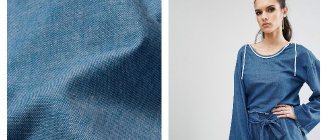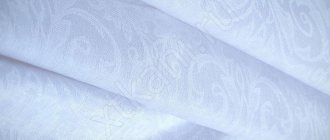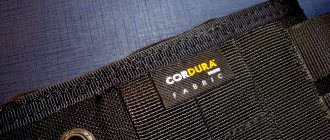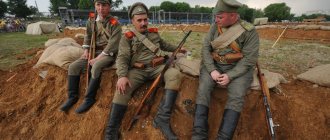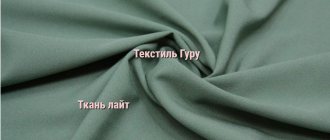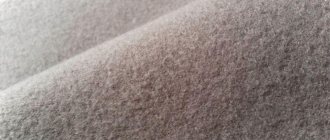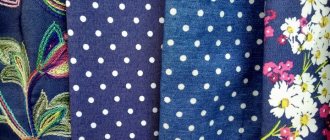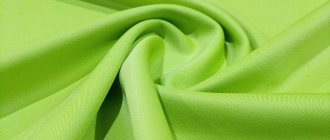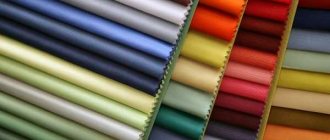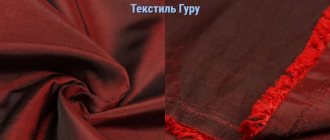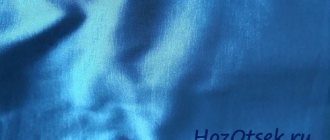Knitted fabrics occupy one of the leading positions in the clothing industry. Their range is quite wide, and not every consumer can determine which fabric is used in the product. Dalgych, not many people know what kind of fabric this is. It owes its appearance to Chinese textile workers, and its popularity to its quality and universal properties.
Description and characteristics
The first acquaintance with the dalgych material took place in early 2000, when China began producing sports trousers. Later, the fabric found application in sewing home clothes and other models.
Dalgych is a synthetic knitted fabric produced in one piece. It feels soft, warm, dense. The front side is smooth with a slight matte sheen. The fabric is stretchable along the weft and lobe, and after removing the load it quickly returns to its original shape. Thanks to its elasticity, it does not restrict movement in the product and does not cause discomfort.
Artificial and synthetic fibers in the fabric are safe, the properties of the material are as close as possible to the characteristics of natural ones. The canvases are dyed at the final stage of processing using environmentally friendly dyes.
You can find out more about the description of the characteristics of dalgych fabric in the table below:
| Properties | Indicators |
| Compound | Mixed |
| Fibers used | Polyester, viscose, spandex, lycra, wool, cotton, less often - silk |
| Structure | Solid knitted fabric with a smooth front side |
| Density, g/sq. m. | 260 |
| Breathability | Below average |
| Water resistance | Average |
| Vapor permeability | good |
| Hygroscopicity | 6 – 12 % |
| Thickness | Depends on the composition and threads used |
| Form stability | Optimal |
| Electrification | High |
| Peelability | Absent |
| Coloring | Plain or printed material |
| Elasticity | High due to special twisting of threads and the presence of stretch fibers |
| Wear resistance | Increased |
| Country of Origin | China |
The canvases are produced plain-dyed and printed. Dalgych is suitable for applying sublimation, while the design is distinguished by its brightness of color and does not fade when washed. The material is wrinkle-resistant, drapes well, and is easy to care for.
What is it used for?
Dalgych is used in the manufacture of various trousers and trousers, since the fabric has an increased degree of resistance to wear. In addition, the material has excellent stretch. In addition, it is easy to iron and wash, so it can be used when sewing a home wardrobe. This type of knitwear is universal when sewing practical and beautiful products for both children and adults.
Dalgych fabric trousers
A wide variety of colors, structure and composition of dalgych is suitable for making any clothing. And the high density helps to create finishing elements in the form of voluminous folds, frills and ruffles. In the photo there is a dress made of dalgych fabric:
Thanks to all the above properties, the material can be used when decorating houses for sewing covers, curtains and other details of home textiles.
Kinds
Varieties of Dalgych knitwear are divided according to the composition of the fibers and the method of dyeing. The fabric goes on sale in three versions:
- smoothly painted;
- printed;
- with and without fleece.
The thickness of the material depends on the threads used. Brushed dalgych is a popular fabric with a noble matte sheen and a smooth surface, with a low pile on the reverse side.
Important! When choosing dalgych fabric for sewing in an online store based on a photo, you need to take into account one feature: the price is indicated per kg. To calculate the required amount of material, you will need to multiply the density value by the area of the fabric.
Example: S = width * length, m., P * density.
A piece of canvas 1.4 * 2 m = 4.8 sq.m. Density = 260 gsm m. 4.8 * 260 = 1248 g.
Thus, to purchase a knitted fabric 140 cm wide and 2 m long, you need to order 1 kg 248 g.
The fabric is combined with other types of knitwear: knitwear, footer, adidas; and materials with similar characteristics.
Reviews
- Irina, 34 years old: “I work in an office, so I need to look the part. At first I chose suits in stores, but then I wanted to get an original, but at the same time discreet suit. I turned to a friend who agreed to sew the chosen model for me. She recommended dalgych fabric as a material. I didn’t know anything about this material before, but I want to say that I really liked it. It looks elegant and is absolutely easy to care for. I wash the suit, iron it, and at the same time it keeps its shape perfectly and remains just as attractive.”
- Anna, 25 years old: “When I was choosing trousers for my job at the bank, I wanted something new and practical. I went shopping for about 2 weeks until I saw trousers made from dalgych in one of them. I really liked their look, so I decided to experiment. I was very pleased with my new purchase. 8 months have passed since then, but my trousers still look like new. They fit me perfectly, don’t stretch, and are machine washable and ironable.”
- Ekaterina, 45 years old: “I used dalgych when I decided to sew myself a skirt. I have a far from ideal figure, so I needed a material that would hide the weight of my flaws. It was Dalgych who turned out to be like that. I sewed the skirt myself, since I have experience in this matter. What I liked most about the skirt I received was how cute it looked. She looked very stylish even on my figure. In addition, it perfectly retains all its qualities when washing and ironing. It’s a pleasure to work with this material.”
Dalgych is a universal material that has a lot of advantages. It is strong, durable, and has an attractive appearance. It is most often used when sewing trousers, although this does not exclude the possibility of using it to obtain other wardrobe items. Tailored products fit perfectly on the figure, hiding its flaws and demonstrating its advantages. You might also be wondering what Milano fabric is. The royal diving fabric looks good.
We also recommend that you read in more detail about viscose: what is Rayon.
Advantages and disadvantages
Dalgych fabric has a lot of advantages, which ensures its high popularity:
- hygroscopicity;
- high wear resistance and abrasion resistance;
- has the ability to retain heat;
- dimensional stability;
- elasticity;
- safety: does not contain or emit harmful components;
- does not pill;
- does not wrinkle;
- drapes well;
- resistant to stains;
- unpretentious in care;
- affordable.
In addition to the pros, there are also cons:
- requires cutting skills;
- accumulates static electricity;
- poor air conductivity.
Compound
The textiles in question belong to the group of mixed fabrics, since they contain several fibers at once. Typically, viscose and polyester threads are combined to produce fabric, and no more than 7% elastane is added to increase elasticity.
Taking into account the thickness of the fibers involved in the production, their origin and external design, one knitted fabric can have a lot of varieties. It contains wool, cotton, silk, viscose, polyester, elastane, lycra, spandex.
Thanks to the use of thick threads and high weave density, the knitwear holds its shape well and does not fray when cutting.
Care instructions
The fabric is low maintenance. By following simple rules, products made from dalgych will last a long time without losing their original attractiveness.
Washable by hand or machine, spin at medium speed in a centrifuge. It is advisable to use gel detergents; the use of chlorine-containing bleaches is unacceptable. The water temperature during washing should not exceed 40°C.
Clothes made from dalgych should be dried in a well-ventilated room away from heating devices, so as not to damage the structure of the polyester fibers. Things are laid out on a horizontal surface or hung on ropes.
Products made from Dalgych knitwear do not require ironing. Ironing from the reverse side in the “synthetic” mode is acceptable. Steaming is prohibited.
Dalgych washes well and is resistant to stains. Therefore, it rarely needs dry cleaning. Exceptions include large size curtains and bedspreads. They can be dry cleaned.
Application
The high consumer characteristics of Dalgych knitted fabric allow it to be used in various areas of the textile industry. Practical clothes are made from it, as in the photo, as well as other textiles:
- suits, trousers, trousers;
- warm dresses, blousons, sweaters, sweatshirts;
- comfortable home clothes;
- decorative bedspreads and capes;
- curtains, lambrequins.
The soft, pliable material is folded, so products made from dalgych are decorated with ruffles, flounces, and frills.
Description of material Dalgych
Dalgych is an interesting knitted material, often used when sewing trousers and trousers. The peculiarity of the fabric is increased wear resistance combined with excellent elasticity.
Its unpretentiousness and undemanding nature make it possible to use dalgych for the manufacture of practical and durable home clothing. The fabric stretches well, is easy to wash, and is not afraid of ironing, spinning and drying. At the same time, it is smooth and pleasant to the touch and has a noble texture.
Thick dalgych can be combined with synthetic elastic fibers such as spandex. The fabric holds its shape perfectly without deforming even under intense loads. This type of clothing fits your figure nicely.
How to wash dalgych?
To fully understand what kind of fabric dalgych is, you also need to figure out how to care for it so that your favorite things remain that way for as long as possible.
The first question that naturally arises when purchasing new clothes is how to wash the dalgych. And there are some tricks here.
The basic requirements are similar to any polyester-based synthetic materials. Any powder will do. You can also use stain removers, but aggressive bleaches are not recommended.
The main limitation is high temperatures during washing and ironing. The usual automatic machine mode for synthetics is suitable, up to 40 degrees. A gentle or delicate mode is also suitable.
Dalgych dries quickly on its own, so it is easy to do without machine drying. The fabric does not require intensive spinning. A light hand spin is sufficient, after which you can carefully hang the product so that it levels out under its own weight. The fabric does not shrink after washing.
It is not necessary to iron the material, but if you have to, it is better to iron it through the lining and at medium temperatures.
Thanks to competent and careful care, you can forever forget about worries about the safety of things that are familiar and dear to your heart. You will no longer have to worry whether the dalgych shrinks after washing, whether it will deform or stretch, whether it will fade, or whether it will get dirty.
grandstock.ru
Analogs
In addition to knitwear, the industry also produces other knitted fabrics, for example, interlock. This material has an identical structure on both sides of the canvas. It resembles a diagram for describing hand knitting “rubber band”, where there is an alternation of front and back columns. This material leaves a feeling of softness, comfort and warmth upon tactile contact. Things made from interlock are very pleasant and comfortable. In addition, they are elegant and spectacular. They do not fade or shrink when washed.
Interlock, unlike kulirka, does not form “arrows” in the event of mechanical damage and does not unravel, which compares favorably with many other knitted fabrics. Another equally attractive property is the very small stretchability of the material in length and width.
True interlock is made only from cotton threads. But sometimes, to reduce consumer prices, some fabric manufacturers add synthetic fibers to the composition. Unlike knitted satin stitch, this fabric has a higher density and is not used for the production of light summer clothing.
- Wedding stitch - what kind of fabric, composition, characteristics, advantages and disadvantages
Another cotton knitted fabric, which is to some extent an analogue of a cooler, is a footer or flannelette. Unlike plain satin stitch and interlock, it has a denser weave. The front side is smooth, and the back side is brushed. Like previous fabrics, the footer is highly breathable, very soft, warm and comfortable to wear. However, unlike interlock and cooler, it shrinks a lot after washing.
Milano fabric: what is it, composition
Until recently, the scope of application of any knitwear (including the now popular jersey) was quite narrow: sewing insulated underwear and elements of work clothes. Everything changed when Coco Chanel started a new fashion. It was her suggestion that people appreciated suits, dresses and jackets made of elastic material. Much time has passed since then, the technologies used in textile production have improved, and the quality of Milano has improved.
This is a mixed or single-component knitwear, as it is now fashionable to say, premium class. Indeed, regular footer, which is often used for sportswear, cannot be compared with it. This can be seen even in our photos. Milano always has a perfectly smooth, matte surface, does not deform, and favorably emphasizes the features of the figure. A total of five types of this material are produced, each of which has its own characteristics. Next, we will give characteristics for each Milano fabric (stretch or not, etc.), and you will find reviews at the end of the article.
What may be included:
- Silk.
- Wool.
- Viscose.
- Polyester.
- Hb.
- Polyamide.
- Spandex.
- Lycra.
This time we cannot give any accurate information regarding the composition of Milano fabric, since even within one type you can count 4-5 variations in components and their percentages.
We suggest you read about the benefits of flock, about which we have a detailed article.
Website about feet
Very often, various items of clothing are made from knitted fabrics for both adults and children. However, some knitted fabrics are also used for sewing various electrical decor and accessories for the kitchen, bedroom, and living room. The main characteristics of knitwear are softness, elasticity, and stretchability. Knitwear can be different in composition - it is made from elastane, wool, silk, cotton, polyester, linen, viscose, etc.Punta
The main advantage of punta is its hypoallergenicity. In addition, it is capable of excellent air permeability. This material is often used when sewing panel curtains.
Dalgych
Various trousers and trousers are made from this fabric, since dalgych has increased wear resistance and stretches well. And due to the fact that it is easy to iron and wash, it is popular for sewing ordinary everyday clothes.
Ribana
This fabric is an elastic material with fairly small stripes. Ribana stretches easily, so clothes made from this material are very comfortable to wear. Very often, ribana is used in the production of children's clothes.
Ribbed fabric
A scar is a material in which the lobar scar is clearly visible. Various products are made from rib, such as curtains, furniture upholstery, some items of clothing, kitchen accessories, etc.
Footer
This fabric, which is made from cotton, is very often used when sewing clothes for women, men and even children. There are two types of footer - three-thread and two-thread. The main characteristics of this material are air tightness and non-allergenic. In addition, the footer holds its shape well.
Velours
Velor is a fabric with a velvety surface. It is strong enough, so it resists various mechanical influences well - it is difficult to scratch or tear. That is why clothes for everyday wear are often made from velor.
Where to buy knitted fabrics?
The best and most convenient way to shop is online. In particular, high-quality knitted fabrics in a large assortment are sold on the website domtkani.com.ua. There are plain and patterned fabrics. In addition, materials vary in color and country of origin. Here are knitted fabrics of different designs - with patterns, stripes, checks, animal prints, abstractions, etc.
Rules of care
General recommendations for fabric care boil down to the following rules:
- Machine wash only on delicate cycle;
- if washing is done by hand, then movements during washing should not damage the structure of the material;
- neutral composition of detergent, without bleaches, chlorine;
- do not leave the wet product crumpled;
- machine spin only at low speeds; after washing, shake the product, straighten it and dry it in a horizontal position;
- iron only from the wrong side, iron the front side only through a damp cloth, you can use a steamer;
- do not store in places exposed to sunlight;
- Some products are dry clean only;
- Store items folded and use soft hangers for clothes.
For fabrics of mixed composition, it is necessary to follow the care recommendations from the manufacturers. In this case, focus on the main components of the mixed fabric.
Manual fabric care
